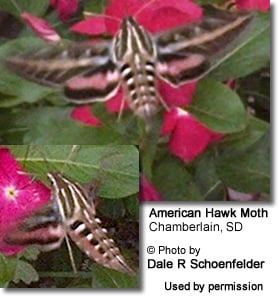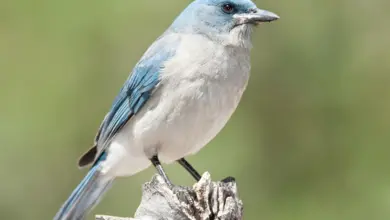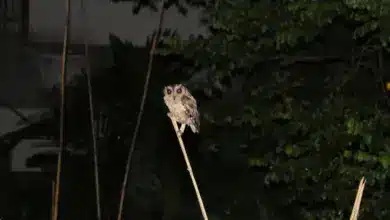Hummingbirds found in New Mexico, USA
Seventeen species of hummingbirds visit New Mexico each year on their migration trail. Identification of the many species is most easily done by the males’ distinctive iridescent throat patches, which range from orange, red, purple, green, blue.
These patches may be restricted to only the throat or, in some species, may extend across the crown or even over most of the head.
In poor light conditions, these color patches may simply look greyish/black, which makes identification more difficult.
Females and juveniles are more difficult to id since they look alike across the different species. However, some physical clues can often be found.
Migrating hummingbirds can be seen in this state during the spring migration, from late March to April; or the fall migration in September or early October.
These following hummingbirds (with photos and ID assistance) have been reported in this state:
Costa’s Hummingbirds (Calypte costae) – Native Breeder. Generally uncommon. Mostly found in Washington County located in the southwest corner of Utah bordering Arizona and Nevada, where they are usually nest in the Virgin River drainage. They usually arrive in Utah in March through June, and leave in September to October.
Males can easily be identified by the glossy purple crown and long, conspicuous throat feathers that project markedly down the side of the throats, giving it an elongated “moustache” appearance. The back is metallic green.
Females have greyish-green crowns (fop of the head) and backs. The chin and the plumage below are whitish, except for some black spotting on her throat. Her flanks are buffy-colored. She has a dark tail with white tips on the outer tail feathers.
They resemble the Anna’s Hummingbirds, but the male’s gorget (throat feathers) is longer than that of the Anna’s.
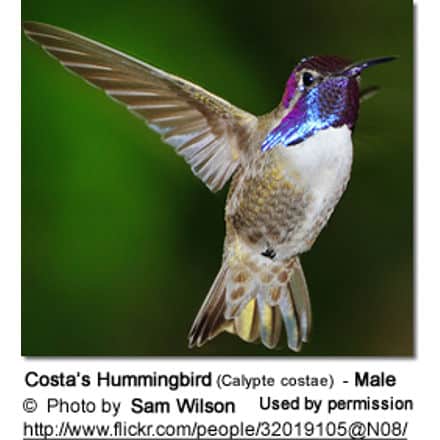
Black-chinned Hummingbirds (Archilochus alexandri) – Fairly common spring and summer residents. In spring, Black-chinned Hummingbirds return to New Mexico from mid-March through May for the breeding season.
The male has a black, shimmering throat with a purple edge and pale feathers below that create a collar. However, unless the light is just right, the head looks all black. His back is green and there are some green feathers covering the chest.
The female is pale below (sometimes with a slightly speckled throat) and her back is green.
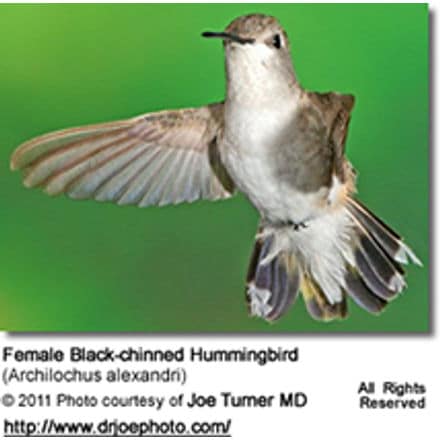
Broad-tailed Hummingbirds (Selasphorus platycercus) – Pass through New Mexico during their migration in September through October.
Males can most easily be identified by their iridescent, rose-red throats, white chest feathers and metallic green back and crown and their rounded tails. The males’ tails make whistling noises in flight.
Females lack the flashy throat patch of the male and are mostly pale below. Their white-tipped outer tail feathers are rust-colored close to the body and blackish in the center; the tail feathers in the center range from green to blackish.
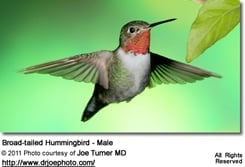
Rufous Hummingbirds (Selasphorus rufus) – Migrating Rufous Hummingbirds pass through New Mexico from mid-July to August.
These hummingbirds are usually found in gardens and at feeders. These birds are fearless, and are known for chasing away other hummingbirds and even larger birds, or rodents away from their favorite nectar feeders and flowers.
Males can easily be identified by their glossy orange-red throats.
Females have whitish, speckled throats, green backs and crowns, and rufous, white-tipped tail feathers.
Calliope Hummingbird (Stellula calliope) – Rare. They may travel through New Mexico during the spring migration in March through May; or during the fall migration from late August through September.
The smallest breeding bird in North America. They are most easily confused with the Rufous Hummingbirds and the Broad-tailed Hummingbird.

Broad-billed Hummingbirds (Cynanthus latirostris) – Accidental / Vagrants – These mostly Mexican hummingbirds venture into the United States regularly; they mostly visit the southern parts. The Santa Cruz watershed, which surrounds Tucson, Arizona, is the northern limit of their breeding range. They generally nest in riparian woodlands and adjacent desert scrub. A few non-breeding vagrants travel as far north as Wisconsin.
The male is glossy green above and on the chest. He has a deep blue throat. His straight and slender beak is red with a black tip. His slightly forked tail is dark above, and the under tail feathers are white.
The female is less colorful than the male. Her throat, chest and belly are light to medium grey. She has a white stripe over each eye.
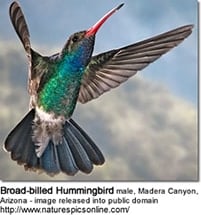
Violet-crowned Hummingbirds (Amazilia violiceps ssp. ellioti) – Rare Vagrants – Occur primarily in Mexico and southwestern to south central United States. They are rare and localized in southwestern New Mexico, mostly in the Madrean Sky Islands – enclaves of Madrean pine-oak woodlands found at higher elevations.
ID: This hummingbird is most easily identified by its white under plumage and iridescent bluish-violet crown (from where it gets its name). The back is emerald green. The tail is dark brown / olive green. The straight and very slender bill is reddish / orangey with a black tip.
Females and juvenile birds look similar to the males, but their plumage is generally less colorful than that of the male and they have a lighter and greener crown.
Anna’s Hummingbird (Calypte anna)
One of the larger and the most vocal hummingbirds in the United States, where it is the only species to produce a song; specifically the males produce a complex series of scratchy noises, sounding like a sharp “chee-chee-chee; when moving from flower to flower, they emit toneless “chip” vocalizations. All other hummingbirds in the United States are mostly silent.
They are well known for their territorial behavior; the male makes elaborate dive displays at other birds and sometimes even at people. At the bottom of their dives, they produce high-pitched loud popping sounds with their tail feathers.
Males have glossy dark rose-red throats and crowns, which may appear black or dark purple in low light. The underside is mostly greyish; and the back metallic green.
Females have light grey chests with white and red spotting on the throat, greenish back and white tipped tails.
They resemble the Costa’s Hummingbirds, but the male’s Costa’s Hummingbird’s gorget (throat feathers) is longer than that of the Anna’s. They are larger than the Rufous Hummingbirds and lack the rusty coloration of the Rufous Hummingbirds.
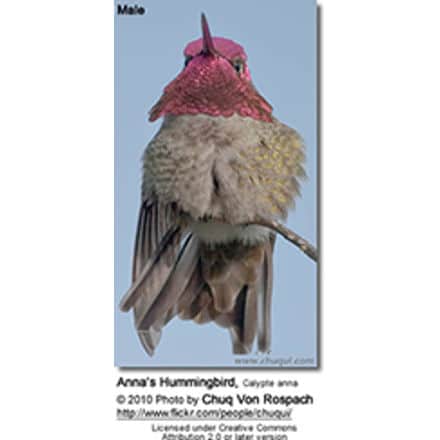
Lucifer Hummingbirds (Calothorax or Trochilus lucifer) – Natives / Rares – Nest in southwest New Mexico – mostly at elevations of about 3,500–5,500 feet (~ 1,000 – 1,600 m). These migratory birds arrive in March or early April for the breeding season and leave early fall (early October) to winter in western Mexico.
ID: Large head; long, thin and down-curved bill; small wings and small, tapered body. Tail is long, narrow and deeply forked, extending well beyond the wingtips. Forehead is green and the back is a drab grey-green. Pale buffy band across the chest. White streak behind the eyes.
Male: glossy magenta to blue-violet throat patch (gorget) that is elongated at the sides and is bordered white on both sides (note: the purple gorget looks black in poor light). The neck and the chest are white. Under plumage is whitish / greyish with greenish and rusty sides.
Female: larger, no flashy throat patch; light brown around the chest and throat area.
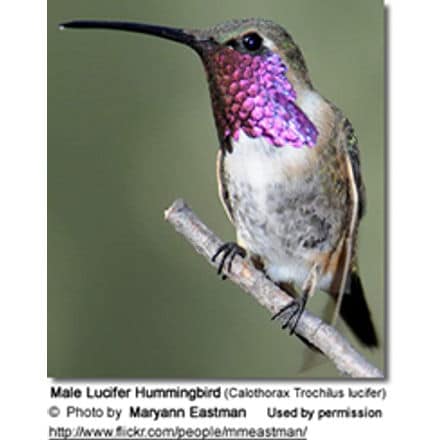
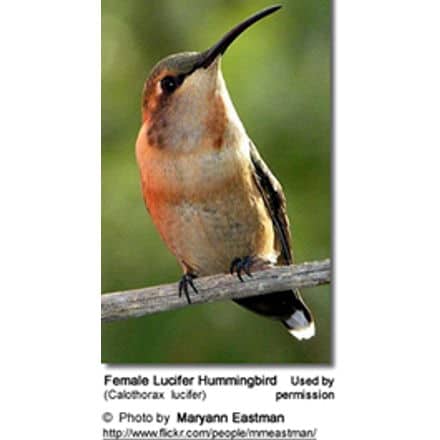
Blue-throated Hummingbirds (Lampornis clemenciae) – Native breeders. They breed in the mountain canyons of southwestern United States, including southern Arizona, southern New Mexico and western Texas; and for the winter migrate south to the mountain woodlands of Mexico, following the highlands and central plateau as far south as Oaxaca.
The upper plumage is dull green, fading to a medium grey on the underside. It has white stripes behind the eyes and a narrower stripe extending backward from the corner of its relatively short bill, next to a blackish cheek patch.
The male can be identified by the iridescent blue throat patch (gorget), which may appear black or grey color in poor light.
The female and young have grey throats.
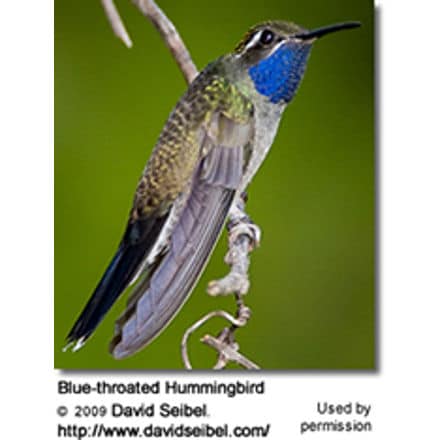
White-eared Hummingbirds (Basilinna leucotis) – Native uncommon breeder. They breed in southeastern Arizona, western and southwestern New Mexico, and west Texas in the USA; their range stretches south to Sierra Madre Oriental (northwestern Mexico), Sierra Madre Occidental (western Mexico), Cordillera Neovolcanica (a mountain range across central Mexico), southern Mexico to southern Nicaragua.
ID: Both the male and female White-eared Hummingbird have a prominent white ear stripe (more boldly colored in the male) for which this species was named.
Magnificent or Refulgent Hummingbirds (Eugenes fulgens) – Rare vagrants
These are large hummingbirds and can often be identified by their size alone.
The male has a metallic green throat and a black chest. His forehead and crown are purple and the back is dark green.
The female plumage is less bright. Her chest is solid grey. Her back and crown are olive green. Her tail feathers are pearl-grey tipped.
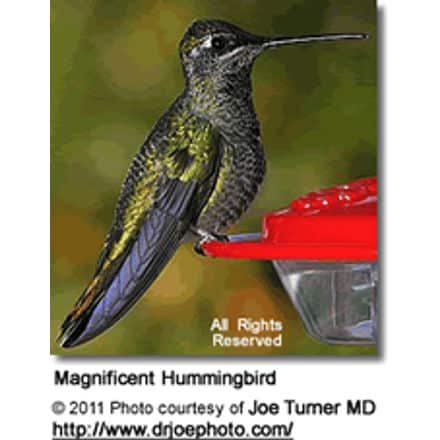
Ruby-throated Hummingbirds (Archilochus colubris) – Rare (non-breeding) vagrants
The male has a ruby-red throat, a white collar, an emerald green back and a forked tail.
The female has a green back and tail feathers that are banded white, black and grey-green.
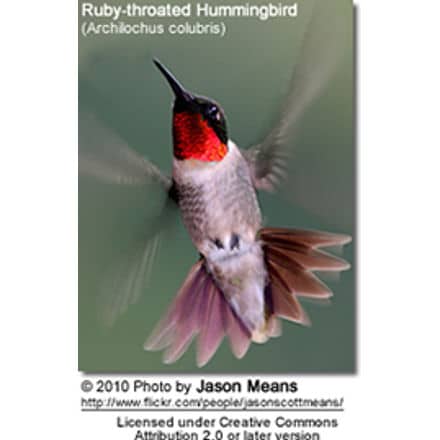
Rufous Hummingbird versus the similar Ruby-throated Hummingbird (Identification)
(Amazilia rutila) – Extremely rare and accidental … The Cinnamon Hummingbirds occur naturally in the United States (Arizona and New Mexico), western Mexico, Costa Rica, Nicaragua, Guatemala, Belize, El Salvador, Honduras and Panama.
This medium-sized hummingbird is bronze green above and cinnamon-colored below. The square tail is reddish with gold and green edging. The long, slim bill has a black tip.
(Amazilia beryllina ssp. viola) – Native, Rare and local summer resident in Arizona and New Mexico. They nest from July through September.
ID: They have shimmering green feathers from their bill to their rump, where the color changes to rufous and extends through their tail feathers.
The tail feathers have a shiny, iridescent purple tint that blends with the rufous color.
Males and females look alike.
Allen’s Hummingbirds (Selasphorus sasin) – Rare visitors – Historically, these birds nested in coastal California and wintered in Mexico; but more and more of them are remaining in California year-round or are traveling to the eastern United States for the winter.
The male has a throat that ranges in color from orange-red to yellow-orange, a back that is bright green, a rump that is rufous and its tail feathers are rufous tipped in black.
The Allen’s Hummingbird is often confused with the Rufous Hummingbird, but the Allen’s can be identified by the green back whereas the Rufous Hummingbird has a coppery back.
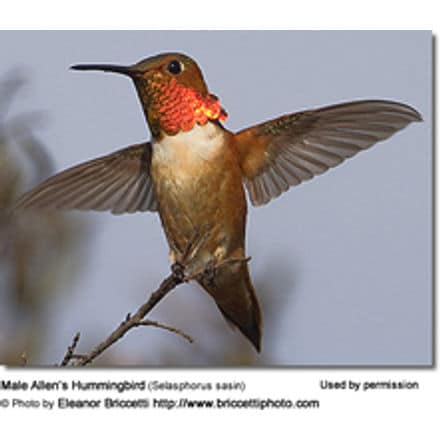
(Heliomaster constantii) – Very rare visitors. These Mexico / Central American natives occasionally visit the United States at the end of the breeding season – mostly in late summer and early fall.
Key ID: Larger in size than most other hummingbirds in the area with a very long bill.
Males and females have a dark, mostly metallic bronze upper plumage (crown, back and tail) with a white patch on the back and rump (lower back – above tail). The plumage below is greyish white. They have a dark eye-stripe with a white stripe above and below.
The male has a metallic violet-red gorget (throat patch) that can look dull blackish in poor light conditions.
The female’s plumage is slightly less colorful and she lacks the throat patch of the male.
WHITE Hummingbird Sightings (Leucistic / Albino)
Is it a Hummingbird or an Insect?
The Hawk Moths (often referred to as “Hummingbird Moth”) is easily confused with hummingbirds, as they have similar feeding and swift flight patterns. These moths also hover in midair while they feed on nectar.
Moths have a couple of sensors or “antennas” on top of the head, which are key identifiers.
If you see a hummingbird that doesn’t appear to be any of the above, please e-mail comments / images to: [email protected]. Thanks!
Hummingbird Resources
- Hummingbird Information
- Hummingbird Amazing Facts
- Attracting Hummingbirds to Your Garden
- Hummingbird Species
- Feeding Hummingbirds

